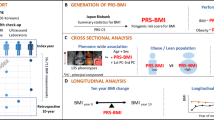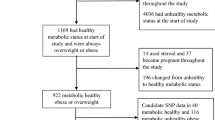Abstract
Objective:
Susceptibility of fat mass and obesity-associated (FTO) gene polymorphisms to obesity has been reported in various populations. Polymorphisms in the melanocortin 4 receptor (MC4R) gene were recently explored as another susceptible locus. However, prognostic significance of these genetic variations has not been fully elucidated. Here, we investigated the involvement of FTO rs9939609 and MC4R rs17782313 polymorphisms in the development of obesity. Association with type 2 diabetes mellitus (T2DM) was also investigated.
Subjects:
We analyzed 2806 community-dwelling middle-aged to elderly subjects (61±14 years). Clinical parameters were obtained from the subjects' personal health records, evaluated at their annual medical check-up.
Results:
FTO genotype was significantly associated with current body mass index (BMI; TT 23.2±3.2, TA 23.7±3.2, AA 24.4±3.2 kg m−2, P=2.5 × 10−6) and frequency of obesity (26.6, 32.0, 43.0% respectively, P=2.0 × 10−4). Age- and sex-adjusted odds ratio for obesity was 1.30 (P=0.004) in TA and 2.07 (P=0.002) in AA genotype. During the 9.4 years comprising the follow-up period, 214 new cases of obesity were diagnosed among 1718 subjects whose retrospective data were available. A allele frequency of the FTO genotype was significantly higher in subjects who developed obesity (22.2, 15.8%, P=0.001), Age-, sex- and initial BMI-adjusted odds ratio for the development of obesity was 1.46 (95% confidence interval, 1.04–2.04) (P=0.031). However, association studies and meta-analysis of T2DM did not actively support the involvement of FTO genotype. No significant differences were observed between the MC4R genotype and BMI (P=0.015), and the frequency of obesity (P=0.284).
Conclusion:
FTO genotype is an independent risk factor for future development of obesity.
This is a preview of subscription content, access via your institution
Access options
Subscribe to this journal
Receive 12 print issues and online access
$259.00 per year
only $21.58 per issue
Buy this article
- Purchase on Springer Link
- Instant access to full article PDF
Prices may be subject to local taxes which are calculated during checkout
Similar content being viewed by others
References
Frayling TM, Timpson NJ, Weedon MN, Zeggini E, Freathy RM, Lindgren CM et al. A common variant in the FTO gene is associated with body mass index and predisposes to childhood and adult obesity. Science 2007; 316: 889–894.
Dina C, Meyre D, Gallina S, Durand E, Körner A, Jacobson P et al. Variation in FTO contributes to childhood obesity and severe adult obesity. Nat Genet 2007; 39: 724–726.
Loos RJ, Bouchard C . FTO: the first gene contributing to common forms of human obesity. Obes Rev 2008; 9: 246–250.
Cornes BK, Lind PA, Medland SE, Montgomery GW, Nyholt DR, Martin NG . Replication of the association of common rs9939609 variant of FTO with increased BMI in an Australian adult twin population but no evidence for gene by environment (G × E) interaction. Int J Obes (Lond) 2009; 33: 75–79.
Hotta K, Nakata Y, Matsuo T, Kamohara S, Kotani K, Komatsu R et al. Variations in the FTO gene are associated with severe obesity in the Japanese. J Hum Genet 2008; 53: 546–553.
Loos RJ, Lindgren CM, Li S, Wheeler E, Zhao JH, Prokopenko I et al. Common variants near MC4R are associated with fat mass, weight and risk of obesity. Nat Genet 2008; 40: 768–775.
Stutzmann F, Cauchi S, Durand E, Calvacanti-Proença C, Pigeyre M, Hartikainen AL et al. Common genetic variation near MC4R is associated with eating behaviour patterns in European populations. Int J Obes (Lond) 2009; 33: 373–378.
Cecil JE, Tavendale R, Watt P, Hetherington MM, Palmer CN . An obesity-associated FTO gene variant and increased energy intake in children. N Engl J Med 2008; 359: 2558–2566.
Berentzen T, Kring SI, Holst C, Zimmermann E, Jess T, Hansen T et al. Lack of association of fatness-related FTO gene variants with energy expenditure or physical activity. J Clin Endocrinol Metab 2008; 93: 2904–2908.
Qi L, Kraft P, Hunter DJ, Hu FB . The common obesity variant near MC4R gene is associated with higher intakes of total energy and dietary fat, weight change and diabetes risk in women. Hum Mol Genet 2008; 17: 3502–3508.
Wardle J, Llewellyn C, Sanderson S, Plomin R . The FTO gene and measured food intake in children. Int J Obes (Lond) 2009; 33: 42–45.
Jess T, Zimmermann E, Kring SI, Berentzen T, Holst C, Toubro S et al. Impact on weight dynamics and general growth of the common FTO rs9939609: a longitudinal Danish cohort study. Int J Obes (Lond) 2008; 32: 1388–1394.
Qi L, Kang K, Zhang C, van Dam RM, Kraft P, Hunter D et al. Fat mass- and obesity-associated (FTO) gene variant is associated with obesity: longitudinal analyses in two cohort studies and functional test. Diabetes 2008; 57: 3145–3151.
Frayling TM . Genome-wide association studies provide new insights into type 2 diabetes aetiology. Nat Rev Genet 2007; 8: 657–662.
Tabara Y, Osawa H, Kawamoto R, Onuma H, Shimizu I, Miki T et al. Replication study of candidate genes associated with type 2 diabetes based on genome-wide screening. Diabetes 2009; 58: 493–498.
Expert Committee on the Diagnosis Classification of Diabetes Mellitus. Report of the expert committee on the diagnosis and classification of diabetes mellitus. Diabetes Care 2003; 26: S5–S20.
Osawa H, Yamada K, Onuma H, Murakami A, Ochi M, Kawata H et al. The G/G genotype of a resistin single-nucleotide polymorphism at −420 increases type 2 diabetes mellitus susceptibility by inducing promoter activity through specific binding of Sp1/3. Am J Hum Genet 2004; 75: 678–686.
Grundy SM, Brewer Jr HB, Cleeman JI, Smith Jr SC, Lenfant C, American Heart Association; National Heart Lung Blood Institute. Definition of metabolic syndrome: report of the National Heart, Lung, and Blood Institute/American Heart Association conference on scientific issues related to definition. Circulation 2004; 109: 433–438.
Examination Committee of Criteria for ‘Obesity Disease’ in Japan; Japan Society for the Study of Obesity. New criteria for ‘obesity disease’ in Japan. Circ J 2002; 66: 987–992.
Horikawa Y, Miyake K, Yasuda K, Enya M, Hirota Y, Yamagata K et al. Replication of genome-wide association studies of type 2 diabetes susceptibility in Japan. J Clin Endocrinol Metab 2008; 93: 3136–3141.
Horikoshi M, Hara K, Ito C, Shojima N, Nagai R, Ueki K et al. Variations in the HHEX gene are associated with increased risk of type 2 diabetes in the Japanese population. Diabetologia 2007; 50: 2461–2466.
Omori S, Tanaka Y, Takahashi A, Hirose H, Kashiwagi A, Kaku K et al. Association of CDKAL1, IGF2BP2, CDKN2A/B, HHEX, SLC30A8, and KCNJ11 with susceptibility to type 2 diabetes in a Japanese population. Diabetes 2008; 57: 791–795.
Mantel N, Haenszel W . Statistical aspects of the analysis of data from retrospective studies of disease. J Natl Cancer Inst 1959; 22: 719–748.
Prentice RL, Thomas DB . On the epidemiology of oral contraceptives and disease. Adv Cancer Res 1987; 49: 285–401.
Greenland S . Quantitative methods in the review of epidemiologic literature. Epidemiol Rev 1987; 9: 1–30.
Zhou BF, Stamler J, Dennis B, Moag-Stahlberg A, Okuda N, Robertson C et al. Nutrient intakes of middle-aged men and women in China, Japan, United Kingdom, and United States in the late 1990s: the INTERMAP study. J Hum Hypertens 2003; 17: 623–630.
Andreasen CH, Stender-Petersen KL, Mogensen MS, Torekov SS, Wegner L, Andersen G et al. Low physical activity accentuates the effect of the FTO rs9939609 polymorphism on body fat accumulation. Diabetes 2008; 57: 95–101.
Rampersaud E, Mitchell BD, Pollin TI, Fu M, Shen H, O'Connell JR et al. Physical activity and the association of common FTO gene variants with body mass index and obesity. Arch Intern Med 2008; 168: 1791–1797.
Willer CJ, Speliotes EK, Loos RJ, Li S, Lindgren CM, Heid IM et al. Six new loci associated with body mass index highlight a neuronal influence on body weight regulation. Nat Genet 2009; 41: 25–34.
Wang LY, Chyen D, Lee S, Lowry R . The association between body mass index in adolescence and obesity in adulthood. J Adolesc Health 2008; 42: 512–518.
Freedman DS, Khan LK, Serdula MK, Dietz WH, Srinivasan SR, Berenson GS . The relation of childhood BMI to adult adiposity: the Bogalusa Heart Study. Pediatrics 2005; 115: 22–27.
Siervogel RM, Wisemandle W, Maynard LM, Guo SS, Chumlea WC, Towne B . Lifetime overweight status in relation to serial changes in body composition and risk factors for cardiovascular disease: The Fels Longitudinal Study. Obes Res 2000; 8: 422–430.
Rong R, Hanson RL, Ortiz D, Wiedrich C, Kobes S, Knowler WC et al. Association analysis of variation in/near FTO, CDKAL1, SLC30A8, HHEX, EXT2, IGF2BP2, LOC387761, and CDKN2B with type 2 diabetes and related quantitative traits in Pima Indians. Diabetes 2009; 58: 478–488.
Freathy RM, Timpson NJ, Lawlor DA, Pouta A, Ben-Shlomo Y, Ruokonen A et al. Common variation in the FTO gene alters diabetes-related metabolic traits to the extent expected given its effect on BMI. Diabetes 2008; 57: 1419–1426.
Timpson NJ, Lindgren CM, Weedon MN, Randall J, Ouwehand WH, Strachan DP et al. Adiposity-related heterogeneity in patterns of type 2 diabetes susceptibility observed in genome-wide association data. Diabetes 2009; 58: 505–510.
Acknowledgements
This study was supported by a Grant-in-Aids for Scientific Research from the Ministry of Education, Culture, Sports, Science and Technology of Japan; the Ministry of Health, Labour and Welfare of Japan; the Japan Arteriosclerosis Prevention Fund; and a Research Promotion Award from Ehime University.
Author information
Authors and Affiliations
Corresponding author
Rights and permissions
About this article
Cite this article
Tabara, Y., Osawa, H., Guo, H. et al. Prognostic significance of FTO genotype in the development of obesity in Japanese: the J-SHIPP study. Int J Obes 33, 1243–1248 (2009). https://doi.org/10.1038/ijo.2009.161
Received:
Revised:
Accepted:
Published:
Issue Date:
DOI: https://doi.org/10.1038/ijo.2009.161
Keywords
This article is cited by
-
Association of a common rs9939609 variant in the fat mass and obesity-associated (FTO) gene with obesity and metabolic phenotypes in a Taiwanese population: a replication study
Journal of Genetics (2016)
-
FTO genotype and aging: pleiotropic longitudinal effects on adiposity, brain function, impulsivity and diet
Molecular Psychiatry (2015)
-
The bigger picture of FTO—the first GWAS-identified obesity gene
Nature Reviews Endocrinology (2014)
-
A polymorphism near MC4R gene (rs17782313) is associated with serum triglyceride levels in the general Japanese population: the J-MICC Study
Endocrine (2014)
-
Obesity genomics: assessing the transferability of susceptibility loci across diverse populations
Genome Medicine (2013)



